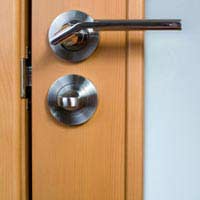Fixtures and Fittings for an Extension

There’s a general rule, when building anything, that 80% of the work is completed using 20% of the effort. The reverse is also true, that finishing the last 20% takes 80% of the effort. And that’s why finishing an extension with all the right details, like fixtures and fittings, seems to take for ever.
It’s a reflection of the fact that detailed work takes time, and with fixtures and fittings spending time on the detail is vital. This is particularly true if you are building the extension to sell a property on at a profit. So it’s important to start looking at the fixtures and fittings well before you actually need them, so that you do not introduce a delay to the project just as it is nearing completion.
Fixtures and Fittings
The sort of fixtures and fittings that we are talking about here are the incidentals, not the major fittings that you need for a kitchen or a bathroom, those are covered in specific articles. So that’s light switches, door handles, windows fittings, hinges, that sort of thing.Some, the hinges for example, will be hidden, and others, like window handles and locks, may come with the windows you buy. Then it’s down to choosing the switches, handles and other fittings that will be on display.
Match Fixtures and Fittings at all Costs
It’s very important to choose fixtures and fittings that match the rest of the property. This level of detail shows the difference between a classy extension and a run-of-the-mill one. If it isn’t possible to buy the same fixtures and fittings any more then scour architectural salvage yards to find fittings that are at least of the right period, if not identical.The worst case is that you may have to replace the fixtures and fittings in the rest of the property to make them all match. This may seem a little extreme, but if it costs a couple of hundred pounds it won’t be a very big proportional increase in the budget, with the extension probably costing tens of thousands. And if it helps to make the property more attractive when it is sold then it may well be worthwhile.
Working with Planners
There is an exception to this rule, and that’s when the extension itself is very different to the rest of the property. This is often the case when the property in question is listed or otherwise protected. Planners often dictate that the new extension should be clearly different from, but complementary to, the existing part of the property.In this case the sky is the limit and you can use different fixtures and fittings to further emphasise this separation between the original property and the new extension. So if the new extension is more contemporary you can go all out with sleek, minimalist lights switches, door handles and other fittings without risking the ambience of the rest of the property. Just be sure to keep a clear dividing line between new and the old.
- Exterior Light and Power for an Extension
- A Home Media Centre in an Extension
- Shades for Conservatory Style Roofs
- Considering Garden Design Following a Home Extension
- Energy Provision In an Extension
- Plumbing and Heating Considerations for a Home Extension
- Plastering and Finishing in a Home Extension
- Installing Electrics In an Extension
- Decorating Your New Extension
- Curtains and Blinds in Your Extended Home


Re: Building Regulations for Windows and Doors
The article on building regulations for windows and doors provides important insights for homeowners planning to…
Re: Building Regulations for Windows and Doors
"This guide is essential for anyone planning home extensions, as it ensures both compliance with building…
Re: When is an Annexe Not an Annexe?
We have a garden room that we built 15 years ago, separate from our house, as an office. 10 years ago we started letting it…
Re: Using a Computer to Plan an Extension
We want to convert an old house back into one property. It was divided into two, pre 1948, so no plans exist from…
Re: When is an Annexe Not an Annexe?
We purchased our house 9 years ago as a whole property with an office annexe which had a bathroom and kitchen of sorts. It…
Re: Can a Door Open Directly From Bathroom to Kitchen?
Hi I leave in 2 bedroom council property, I have the bathroom downstairs on the ground floor where the…
Re: Keeping in With the Neighbours
My upstairs neighbour is thinking of converting her side bedroom window into french doors and attaching a narrow staircase to it…
Re: When is an Annexe Not an Annexe?
I gained planning for a garage, gym, shower room, WC and playrooms above. For one year my elderly parents stayed using the…
Re: When is an Annexe Not an Annexe?
I have just had a recent conversion of an existing workshop into a annex. It only has a toilet and sink, small area with…
Re: When is an Annexe Not an Annexe?
Difficult one this.So we have permission granted to build an annex.The planning quote as follows. . The proposed…